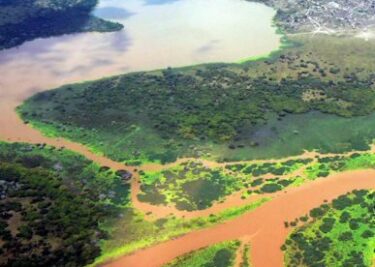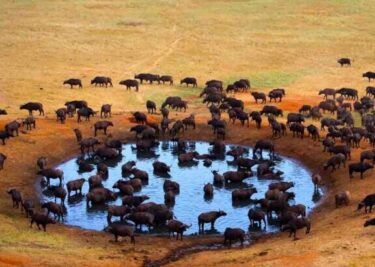A Gem in the Desert: Mt. Kulal Biosphere Reserve

Image credit: Facts East Africa | X
On the eastern shores of Lake Turkana, where the waters meet the sands, the landscape gives way to a vast coarse stretch that characterises the Chalbi Desert. Zooming into the desert’s blue horizon reveals a mass rising magnificently as if in mockery of Chalbi’s flatness and exerting its stature across over 750 square kilometres. This is Mt. Kulal, an eroded extinct volcano in the iconic Marsabit County locally referred to as ‘a gem in the desert’ for its spectacular presence amidst arid and semi-arid conditions.
Iconic Montane Forest Ecosystem
Kulal is a mountain of ruggedly imperfect perfections. A deep ravine from an old crater splits the mountain into two, a northern and southern side. Horizontally, wide gorges that go hundreds of metres deep run from east to west, giving the mountain a marvelous aerial appearance like that of a leaf vein.
A UNESCO Man and Biosphere Reserve
At the peak of the mountain is vibrant evergreen forest covered in a misty blanket which sets the mountain apart from the surrounding desert ecosystems.
As the highest point in the region, Mt. Kulal is a significant hydrological system. Beyond its rugged terrains, its misty, rainy top and streams of ever-flowing water winding down provide sustenance for its biodiversity and support local communities’ livelihoods.
For this significant hydrological and ecological importance, the Mt. Kulal ecosystem was designated a UNESCO Man and Biosphere (MAB) Reserve in 1979. It is a habitat to over 900 plants species, 20 mammal species, including the Naked-rumped Tomb bat, the Samburu Serotine bat that’s endemic to Kenya, and reptiles like the Kulal Chameleon.
While its avifaunal diversity count is low, Mt. Kulal serves as a refugium for migrant bird species. In 2023, the biosphere reserve was recognised as a secondary endemic bird area as it’s also home to several other bird species of conservation concern.
Conservation Challenges
Despite being an oasis of ecological importance, the Mt. Kulal Biosphere Reserve ecosystem hasn’t been devoid of conservation challenges. In the 1970s, Mt. Kulal’s large mammals, the African Bush Elephants and Cape Buffaloes, were poached to extinction. In 2024, climate change poses a threat to this resilient ecosystem, but it continues to defy the odds of being situated in one of East Africa’s driest regions.
Fostering Inclusive Conservation
The reserve has only weathered these challenges due to the joint conservation efforts made by the community, Marsabit County government, and other environmentalists. It is arguably one of the most conserved forests in the country despite not being formally protected. While the county government partakes in awareness creation and capacity building, the local community fuses its indigenous knowledge and traditional forest conservation practices with science to foster sustainable use of Mt. Kulal’s resources and values.
Although on the tentative list awaiting inscription to the UNESCO World Heritage Sites List, Mt. Kulal Biosphere Reserve thrives in its beauty and generosity as a treasure trove of biological diversity and the spring of life where communities and their livestock drink from. Truly, a gem in the desert.



